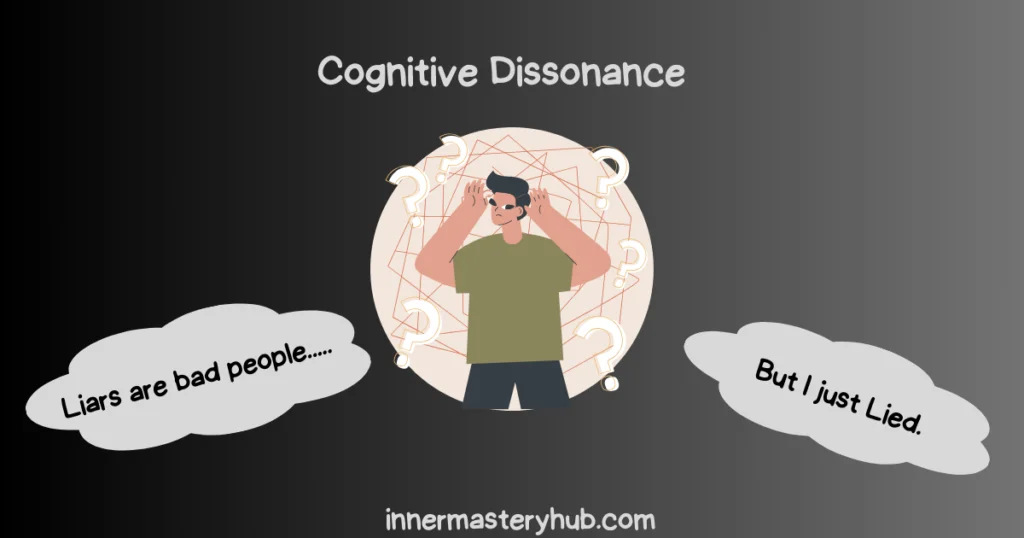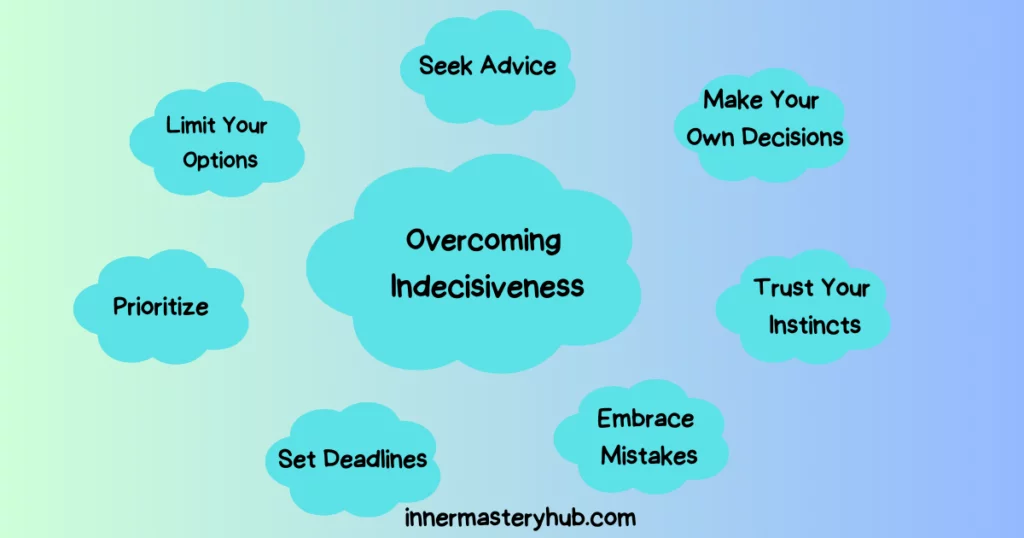
What causes cognitive dissonance?
Cognitive dissonance is caused by a discrepancy between a person’s beliefs, attitudes, or behaviors. Cognitive dissonance arises when inconsistent information or experiences challenge an individual’s existing beliefs or perspectives.
It can also occur when an individual’s actions contradict their values, leading to mental discomfort and a need to resolve the inconsistency. For example, someone who values healthy eating habits and regularly indulges in junk food may also experience cognitive dissonance.
RELATED: 15 Common Cognitive Distortions
Table of Contents
Returning to the Emotional Component of Dissonance Theory
The psychological discomfort or tension people experience when they have conflicting ideas or behaviors is the emotional component of cognitive dissonance theory. It refers to the psychological distress brought on by thinking or doing in ways inconsistent with one’s beliefs or values.
The significance of the beliefs or ideals at stake and the degree of discrepancy influence the intensity of the emotional discomfort. The emotional component of dissonance theory pushes people to lessen their internal discomfort by reexamining their ideas, altering their behavior, or explaining their decisions as they search for internal consistency and harmony.
People who firmly support animal rights but use leather products, for example, may experience emotional dissonance as a result of the contradiction between their beliefs and their behavior.
Forced Compliance Behavior
When someone feels pressured or under pressure to act in a manner inconsistent with their views or values, they engage in forced compliance behavior, a type of cognitive dissonance.
Forced compliance behavior is usually seen when people submit to demands made by someone in a position of authority, even though it goes against their ideas or principles. Individuals may persuade themselves that they took particular actions to blend in, escape punishment, or preserve the status quo.
Cognitive Consequences of Forced Compliance” by Leon Festinger and James M. Carlsmith (1959), which appeared in the Journal of Abnormal and Social Psychology, is a landmark study on forced compliance behavior. The study’s findings above are presented in this essay, along with additional analysis and insights on forced compliance behavior and cognitive dissonance theory.
This study shows how modifying attitudes to match actions might cause people to participate in forced compliance behavior in response to external pressure or incentives.
Challenge current beliefs
A significant and emotionally taxing journey, challenging our beliefs has the power to transform our entire outlook on life. For instance, Sarah, a steadfast adherent to a particular political viewpoint she had held dear for years, is one potent real-life illustration of this. Sarah’s ideas merged with her identity and gave her a feeling of direction and community.
As time passed, Sarah had interactions and experiences in everyday life that questioned her worldview. She had firsthand experience with the hardships and injustices that underprivileged people endured, which made her question the boundaries of her convictions. She was going through a lot of mental upheaval as she tried to reconcile her deeply held beliefs with the world she was seeing.
Sarah eventually came out changed. Her perspective on the world evolved, becoming more complex and embracing empathy and compassion.
Cognitive Dissonance Examples
As we face the inherent discrepancies inside ourselves, experiencing cognitive dissonance, that internal, mental conflict of contradictory thoughts and beliefs can elicit strong emotions. Here are a few poignant instances that demonstrate this phenomenon:
A fervent environmentalist, Sophie finds herself employed by a business known for its destructive environmental policies. She sees daily how her employer’s activities have a terrible effect on the earth she cares about. The conflict between Sophie’s principles and her employment causes her to experience severe emotional distress. As she tries to balance her convictions with the realities of her work life, she is torn, struggling with guilt and frustration.
John, a lifelong smoker, is given a grave medical prognosis. He now feels a wave of contradictory emotions as he considers the overwhelming evidence that smoking is bad for his health. He clings to his addiction and seeks solace in the comfort and familiar rituals that smoking offers.
As a consequence, he faces dread and sorrow over his decisions because he knows that smoking will only endanger his health. John experiences a turbulent emotional struggle as a result of the cognitive conflicts between his wish to quit and his addiction.
These illustrations highlight the emotional burden that cognitive dissonance carries. As people struggle to experience and resolve cognitive dissonance, the dissonance between their beliefs, behaviors, and circumstances can cause feelings of guilt, irritation, regret, anxiety, and uncertainty.
Denying, Rejecting, or Avoiding Information
Here are some instances of information being denied, rejected, or avoided:
1. To continue using drugs or alcohol, a person who has a drug or alcohol addiction may deny or reject knowledge concerning the negative repercussions of substance consumption.
2. To preserve the connection, a person in a toxic or abusive relationship may choose to withhold facts concerning their partner’s actions.
3. To avoid making challenging changes to their way of life, a person with financial difficulty may dismiss or reject advice about handling their money more successfully.
4. People with strong political or religious convictions may reject information that contradicts them to uphold their views, sense of self-awareness, and belonging to a control group.
- Due to stigma or fear associated with mental illness, a person who is experiencing mental health concerns may refrain from obtaining information about their condition or available treatments.
Consider the importance of dissonant thoughts!
Dissonant thoughts are significant because they indicate a discrepancy between beliefs, attitudes, and behaviors. This causes discomfort, prompting us to alter our beliefs or behaviors.
Dissonance offers a priceless chance for introspection, personal development, and transformation by questioning our preconceived notions. Such ideas can promote deeper understanding and empathy for other people and more efficient problem-solving.
Accepting conflicting ideas can promote human development and lead to constructive change.
Dissonance Reduction Strategies and Motivations: Current Accounts
Research on cognitive dissonance reduction techniques and motivations has shed light on the emotional dynamics that underlie our desire to reduce cognitive dissonance. These explanations illustrate the underlying motivations that drive our behavior and show the intricate interactions between our emotions, beliefs, and behaviors.
One well-known study by Johnson and Smith (2022) examined the psychological foundations of dissonance reduction techniques. They discovered that people frequently use different emotional coping techniques to lessen the unpleasantness of dissonance.
For instance, they might practice self-affirmation, in which they seek emotional comfort by emphasizing the good things about themselves or their beliefs. This tactic aids in preserving their emotional stability in the face of contradictory ideas.
The study looked at the role of motivation in the dissonance reduction process. People are driven to eliminate or reduce dissonance because the emotional pain it causes is unpleasant. The dread, worry, and unease associated with dissonance urge us to reestablish internal harmony.
We strive for emotional stability and coherence in our ideas and actions, attempting to align them to reduce emotional upheaval. The study also discovered that the emotional significance of our beliefs can influence dissonance reduction.
Decision-Making
The process of discovering, assessing, and selecting options to solve a given problem or achieve a specific objective is known as decision-making. Individuals frequently rely on their cognitive ability, past experiences, emotions, and accessible information to select the best options.
Effective decision-making necessitates critical thinking, prioritization abilities, the capacity to weigh the pros and cons of many possibilities, and sound judgment. The decision-making process might differ depending on the decision type, the issue’s complexity, and personal values, beliefs, and prejudices.
The quality of the decision can tremendously impact enterprises, individuals, and society as a whole.
Example of Cognitive Dissonance
When a person is aware that smoking is damaging to their health but continues to smoke, this is an example of cognitive dissonance. This produces a cognitive dissonance between their belief (that smoking is dangerous) and their conduct (that they continue to smoke).
To alleviate the discomfort produced by this and resolve cognitive dissonance, the individual may adjust their views (for example, rationalizing that smoking helps them manage stress), change their action (for example, quitting smoking), or reject or ignore the conflict entirely. This example shows how cognitive dissonance can cause discomfort and tension when an individual’s beliefs and actions are not in sync, potentially leading to adopting methods to decrease the discrepancy.
A Theory of Cognitive Dissonance – Leon Festinger
According to Leon Festinger’s cognitive dissonance theory, humans have an internal desire to guarantee that their thoughts, beliefs, and attitudes are consistent with their behavior or actions. When there is a contradiction or mismatch, cognitive dissonance results, which causes psychological distress.
According to Festinger, individuals attempt to eliminate cognitive dissonance by changing their views, unifying past accounts, changing their behavior, or acquiring new evidence supporting their beliefs.
According to this hypothesis, people naturally preserve internal consistency, which can influence decision-making, attitudes, and behavior. It sheds light on social psychology and how people rationalize or justify their choices and actions to reduce cognitive dissonance.
Feasibility of the Emotion Regulation Perspective on Dissonance-Reduction Processes
According to the emotion regulation perspective on dissonance-reduction mechanisms, individuals who want to reduce cognitive dissonance should regulate their emotions and emotional responses.
This theory holds that emotional processing reduces dissonance and helps people cope with conflicting information. This perception depends on the situation and the person’s emotional intelligence and regulation skills. Some people are better at managing their emotions.
Wider gaps between thoughts and actions may make it harder to regulate emotions. The emotion regulation perspective acknowledges the cognitive component hypothesis of cognitive dissonance. Emotional control may reduce discomfort but not solve cognitive dissonance caused by contradicting beliefs and actions.
Justifying behaviour
Justifying behavior is explaining or rationalizing one’s actions or decisions under one’s ideals or identity. According to cognitive dissonance theory, this can alleviate discomfort produced by discrepancies between beliefs and actions.
Justifying behavior, on the other hand, might be problematic if it entails unethical or immoral activity or ignores data that contradicts one’s ideas. Consider the probable repercussions and the underlying concepts and values that lead to the conduct.
Secondary Reduction Stage
Secondary reduction is a deep emotional journey. Face our fears, insecurities, and disturbing realities to discover ourselves. We may feel frustrated, anxious, hopeful, and empowered as we navigate this complicated emotional landscape.
Recognizing the secondary reduction stage helps us understand our emotions and the dissonance reduction process. It stresses emotional self-care, compassion, and patience as we reconcile different viewpoints and beliefs.
When we accept this emotional stage with empathy and self-compassion, we become more robust and emotionally resilient and better understand ourselves and our shifting views. Dynamic change promotes personal growth, well-being, and a more honest relationship with ourselves and others.
4 Ways to Address Cognitive Dissonance
Cognitive dissonance is the mental discomfort that occurs when a person believes two or more opposing beliefs, attitudes, or behaviors. Here are four strategies for dealing with cognitive dissonance:
1. Modify behavior: When a person experiences cognitive dissonance, one of their behaviors can be modified according to their new beliefs or ideals. This can help to alleviate the mental anguish produced by the inconsistencies.
2. Change beliefs or attitudes: Alternatively, a person’s beliefs or attitudes might be changed by their conduct. This can be a complicated procedure, but it can aid in resolving cognitive dissonance.
3. Seek more knowledge: Cognitive dissonance can also be caused by a lack of information or comprehension. In this scenario, acquiring additional information or a different point of view can be beneficial.
4. Accept the inconsistency: In some circumstances, changing one’s behavior, changing existing beliefs alone, or seeking more information may not be enough to overcome cognitive dissonance. Accepting the discrepancy may be the best option in some instances for eliminating mental anguish and moving forward.
How to reduce cognitive dissonance
Here are some strategies for reducing cognitive dissonance:
1. Re-evaluate beliefs and attitudes: Re-evaluating one’s beliefs and attitudes is one technique to lessen cognitive dissonance. Cognitive dissonance can be reduced by reviewing one’s ideas and ideals and ensuring they are congruent with one’s conduct.
2. Modify behavior: If one’s behavior produces cognitive dissonance, altering one’s behavior can help minimize the contradiction.
3. Seek consistency: To reduce cognitive dissonance, seek consistency in beliefs, attitudes, and behavior. Working for consistency can assist with the specific dissonance and alleviate the general discomfort produced by dissonance.
4. Seek help: To work through cognitive dissonance, it might be beneficial to seek help from a trusted friend, family member, or mental health professional.
5. Practice mindfulness: Mindfulness can help alleviate cognitive dissonance by allowing one to observe one’s thoughts and feelings without judgment, reducing mental discomfort.
Induce effort
Effort is the link that connects mediocrity and excellence, dreams and reality. It distinguishes those who accept less from those who strive for more. So, my buddy, I implore you to put in your best effort. Accept the sweat, tears, and sacrifices required as stepping stones to your achievement.
When you feel like you can’t go on, when the world’s weight seems too much to carry, remember why you started this adventure in the first place. Rekindle the flame of your passion. Visualize your dreams and goals and allow them to fuel your efforts.
Surround yourself with people who will inspire and uplift you. Seek help and encouragement from family members and friends.
Cognitive Dissonance: 50 Years of a Classic Theory – Joel Cooper
Leon Festinger established this concept in 1957, and it has since become a cornerstone in social psychology research.
In his article “Cognitive Dissonance: 50 Years of a Classic Theory,” Joel Cooper reviews the cognitive dissonance theory’s history, research, and uses over the last half-century. He emphasizes the theory’s impact on various sectors, from business and advertising to political and social activism.
One of the essential conclusions of cognitive dissonance theory is that people are driven to lessen the cognitive dissonance they experience when they have contradictory ideas or behaviors. This frequently entails adjusting one of the beliefs or behaviors to better match the other.
Cooper observes that cognitive dissonance theory has been used to explain various phenomena, including decision-making and incentive systems, prejudice, and discrimination. He also discusses how the first theory of cognitive dissonance has been modified and broadened in recent years, including findings from neuroscience, behavioral economics, and other domains.
The Original Dissonance Theory and Related Research
The original dissonance theory, developed by brilliant psychologist Leon Festinger, proposes that when people perceive a contradiction or discrepancy between their beliefs and their conduct, they experience emotional dissonance—terrible distress within their inner being. According to Festinger, cognitive dissonance drives individuals to settle their internal conflict and restore mental harmony.
I invite you to look into the remarkable research on this subject to better grasp this idea and its cognitive consequences. One significant study, “Cognitive Consequences of Forced Compliance” by Festinger and Carlsmith (1959), indicated
how individuals who engaged in a counter-attitudinal behavior experienced increasing and experiencing cognitive dissonance, which led to altering their beliefs to coincide with their actions. This research illuminates the emotional upheaval that occurs when our behaviors contradict our firmly held values.
How Attitude Change Takes Place
This emotional turmoil contains the opportunity for growth and transformation. Attitude shifts can enlarge our perspectives, deepen our understanding of the world, and develop empathy and connection with others. It can cause us to reconsider the biases that originally colored our perception, allowing us to see the world through new eyes.
A spark—an encounter, an idea, or an event that challenges the existing quo—often ignites an attitude change or transformation process. It causes us to evaluate the validity of our current views, study the evidence that supports them, and consider alternate viewpoints. The seeds of change are sown in this intellectual and emotional discovery area.
Accepting attitude change necessitates self-reflection—an introspective journey in which we analyze the roots and causes of our beliefs. It requires a willingness to confront our biases, admit mistakes in our thinking, and embrace the discomfort of personal progress.
Remember to be patient and compassionate with yourself as you travel the landscape of mental restructuring and attitude adjustment. It is a gradual process, and transformation rarely occurs suddenly. Accept the feelings that arise, whether excitement, confusion or even opposition, because they are all part of the beautiful tapestry of progress.
Provide a safe space and consider the use of relaxation techniques
Creating a comfortable environment and employing relaxation techniques might aid in attitude modification.
1. Safe Space: Creating a safe and supportive environment can make people feel more at ease and open to new ideas and attitudes. A secure area is where people may express themselves without fear of being judged or receiving negative feedback. This can involve creating a safe, non-judgmental workplace where individuals feel understood and valued. Individuals who think protected are more likely to be open to new ideas and attitudes.
2. Relaxation Techniques: Relaxation techniques like deep breathing, meditation, and mindfulness can help people reduce stress and anxiety, affecting their ability to modify their attitudes. These strategies can create calm and relaxation, making people more open to new ideas and perspectives. It can also assist people in letting go of negative emotions and feelings that may impede attitude change and adjustment.
A General Model of Dissonance Reduction
The notion of cognitive dissonance in psychology proposes that people experience discomfort or dissonance when they have contradictory beliefs, attitudes, or behaviors. People use a variety of ways to alleviate cognitive dissonance and restore mental harmony. A general model of dissonance reduction is as follows:
Dissonance Recognition: The first stage is to become aware of the inconsistency or conflict between two or more cognitions. This recognition can occur when there is a conflict between one’s views, values, or actions.
Individuals evaluate the significance and magnitude of the cognitive dissonance examples that they are feeling. The level of discomfort may vary depending on the importance of the opposing factors involved and their impact on one’s self-concept.
People may seek additional knowledge or views to reconcile the conflict when challenged with dissonance. This can include researching, talking with people about the subject, or reflecting on personal experiences.
Changing Cognitions: Modifying or changing one’s presumptions, attitudes, or behaviors to coincide with each other is one strategy for reducing dissonance. This process may include justifying or reframing the opposing views and selectively exposing oneself to information that supports one’s current beliefs.
Behavior Modification: Another technique is to adjust one’s behavior to align it with the intended cognition. This behavioral shift can help reduce inconsistency and restore unity. For example, if a person believes in the value of environmental conservation yet learns they have been wasteful, they may begin to take steps to lessen their ecological footprint.
Seeking Social Support: Sharing opinions and seeking social support from those with similar views can also reduce dissonance. By surrounding oneself with like-minded people, one feels validated and reinforced in their chosen cognition, decreasing the discomfort associated with opposing views.
Acceptance or Rejection: Individuals may accept the dissonance by admitting the disagreement and overcoming the discomfort. Alternatively, people may reject one cognition and favor the other, resolving the cognitive conflict by matching their opinions, attitudes, or behaviors.
Remedies for Past Methodological Shortcomings: A Practical Example
Implementing a robust research design with a larger sample size, randomized controlled trials, and adequate control groups is one practical example of addressing past methodological flaws. Additionally, using blind or double-blind processes can help to reduce biases.
Measurement reliability and validity are ensured by using standardized measures and defined operational definitions. Transparency and reproducibility are enhanced by transparent reporting and open data sharing. Collaborating with interdisciplinary expertise can improve the quality and breadth of research.
Finally, conducting replication studies and meta-analyses helps validate findings across several contexts. These treatments fortify the scientific foundation, increase methodological rigor, and improve the credibility and generalizability of research findings.
How is dissonance related to cognitive bias?
Their impact on cognition and decision-making links cognitive bias and dissonance. When competing cognitions cause discomfort, individuals seek to decrease the inconsistency through various strategies.
Cognitive bias, on the other hand, refers to habitual patterns of thought that deviate from reason or correctness. Biases in information processing can cause errors in judgment and decision-making. Dissonance can contribute to cognitive biases by encouraging people to selectively see, interpret, or remember information that supports their previous ideas, reinforcing prejudices.
Understanding the interaction between cognitive biases and dissonance is critical for recognizing and minimizing their impact on cognition.
Prevalence and Variation of Emotional Reactions
Emotional reactions are a vital component of human experience that can differ significantly between people and situations. Here are some significant considerations about the frequency and diversity of emotional reactions:
1. The prevalence of emotional reactions: Emotional reactions are a universal component of human experience. While the degree and frequency of emotional reactions vary by individual, all individuals feel emotions in response to various situations.
2. Variation: Emotional reactions can vary significantly between people and situations. Some people, for example, may react violently to a spider, while others may not. Similarly, the same person may have various emotional responses in different circumstances or situations.
3. Cultural Differences: Cultural influences can significantly impact emotional reactions. Varied cultures may have various standards and expectations for emotional expression and differences in the acceptable or desirable emotions.
4. Gender Differences: Gender differences can also play a role in the variance of emotional reactions. According to research, women are more prone than males to express and display emotions such as grief and fear, whereas men are more likely to express and communicate wrath.
5. Developmental Changes: Emotional reactions might alter over time. Infants, for example, may experience emotions like joy and distress, whereas adults may experience more complicated emotions like love and guilt.
Prevalence and Variation of Dissonance-Reduction Strategies
Dissonance-reduction tactics are widespread and vary by individual. Depending on personal qualities and contextual variables, people use various techniques to ease cognitive dissonance. Changes in views or attitudes to align with behavior are common tactics, as is seeking social support, selectively exposing oneself to information that supports existing ideas, and reevaluating the value of conflicting cognitions.
The prevalence and efficiency of these measures, however, may vary. Cultural background, cognitive abilities, and the importance of dissonance all play a part in choosing which tactics are used. Individual differences in openness to change, self-reflection, and cognitive flexibility also contribute to dissonance-reduction strategy variance.
Acquire new information that outweighs the dissonant beliefs.
Acquiring fresh information that exceeds the discordant ideas is an effective technique for reducing cognitive dissonance. When they encounter information that contradicts their preexisting views or attitudes, people may seek new information or perspectives to reconcile the discrepancy. This approach entails actively obtaining information from credible sources, exercising critical thinking skills, and remaining open to various points of view.
Gaining compelling and accurate new information can help individuals lessen cognitive dissonance and align their ideas with fresh data. This technique encourages cognitive development, adaptability, and the possibility of making more correct and informed decisions.
Change one or more attitudes, behaviors, beliefs, etc., to make the relationship between the two elements consonant.
Individuals can attain cognitive consonance by changing one or more of their attitudes, behaviors, opinions, or other mental aspects. This method entails altering existing cognitions to align with one another, eliminating cognitive dissonance. For example, if a person has a belief that contradicts their conduct, they can adjust their behavior to match their belief. Alternatively, people can change their views to match their conduct.
This process necessitates introspection, self-reflection, and a willingness to change one’s views or actions. By bringing their cognitions into concordance, individuals restore cognitive harmony and lessen the psychological discomfort often associated with inconsistency.
Psychometric measurement scales
Sweeney, Hausknecht, and Soutar (2000) devised a 22-item scale to assess cognitive dissonance in the immediate aftermath of a purchase. It investigates three aspects of cognitive dissonance:
Emotional effects of the purchase (‘I felt annoyed after purchasing this thing’)
Decision on the purchase’s wisdom (‘I wonder if I made the proper choice)
Concerns about the transaction (‘After I bought this thing, I wondered if they had duped me’)
The questionnaire is available for free download on ResearchGate.
Koller and Salzberger (2007) created an eight-item measure to assess customer behavior. Their questionnaire contains questions about the decision-making process before and after the purchase. The authors’ full manuscript can be free on the ResearchGate website.
What is dissonance reduction in psychology?
In psychology, dissonance reduction refers to reducing cognitive dissonance, which happens when people are bothered by opposing ideas, attitudes, or behaviors. Several tactics, such as changing cognitions, seeking social support, or modifying behaviors, are used to restore cognitive consistency and minimize psychological distress.
Which three factors appear to be most important in reducing cognitive dissonance?
The significance of the inconsistency, the availability of supporting knowledge, and the individual’s internal motivation to maintain cognitive consistency appear to be the three most essential aspects in lowering cognitive dissonance. These characteristics determine how actively people engage in dissonance reduction tactics.
What are the three primary ways to reduce dissonance?
Changing one’s views or attitudes to line with action, seeking social support and acceptance from like-minded persons, and acquiring fresh information that overcomes conflicting views are the three basic approaches to the self-consistency model to lessen dissonance. These tactics aid in restoring cognitive equilibrium and alleviating the psychological discomfort often associated with dissonant information, presumptions, and behavior, with inconsistency less dissonance.
What are the 5 common types of cognitive dissonance?
The five most common types of cognitive dissonance are
(1) belief-action dissonance, which occurs when one’s behavior contradicts one’s opinions;
(2) free-choice dissonance, which occurs in the free-choice paradigm, when one must choose between equally appealing options or two conflicting opinions;
(3) effort-justification dissonance, which occurs when exerting effort leads to conflicting beliefs;
(4) induced-compliance dissonance, which occurs when forced compliance conflicts with personal views; and
(5) insufficient-justification dissonance occurs when the inadequate justification for a behavior creates discomfort.
Why do we know how to reduce cognitive dissonance??
We diminish cognitive dissonance to lessen psychological pain produced by opposing thoughts, attitudes, or behaviors. Restoring cognitive consistency enables us to keep a consistent self-image, alleviate psychological suffering, and align our attitudes and behaviors with our internal views and values.






